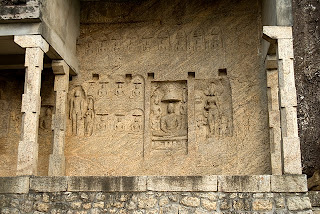Ancient Jain Monuments in Chitharal
Chitharal is a small village situated at a distance of 7 Kms., from Marthandam and 55 Kms, from Trivandrum. It is famous for the Rock-cut temple. Hillock at Chitharal has a cave containing Rock-cut sculptures of Thirthankaras and attendent deities carved inside and outside dating back to 9th Century A.D.
Chitharal was also known by the name Thirucharanathupalli or the Thirucharanamalai in the earlier days which was the abode of the Digambara Sect of the jain Monks.
Chitharal is a tranquil and calm spot and a confluence of history and religion, you can experience the sernity after your hard and tedious climb up the hill. Chitharal / Chidaral is becoming a tourist destination in its own rights for the beautiful and panoramic views they can get from the top of the hills.
There is a hillock which has a cave containing the rock cut sculptures of the Jain Thirthankaras and the attendent deities. These sculptures are carved inside and outside the cave dating back to the 9 AD. Jain influence in the region is believed to be due to the Jain King Mahendravarman I during the 7th century. Later the area was converted to Bagawathy temple which is believed to be in the 13th century.
The climb to the Chitharal Parsvanatha and Mahavira temple
There is an arch which reminds you of the Kerala Architecture welcomes you. After that it is a hard climb for about 10 - 15 minutes. It would be better if you coud reach here early in morning before the sun starts beating you down. As you reach the top you can get the panoramic and spectacular views of the valleys, Western Ghats , rivers and roads coconut and palmyra groves villages dotted here and there and many more.There is a narrow opening between the two rocks resting against eachother, squeeze through this opening and go down the natural stair case. On the northern side there are carved images of Thirthankaras with their distinct hanging earlobes, the three-tiered umbrella over their tonsured heads, in sitting and standing postures. The carved figures also have broad shoulders, slender waists and a contemplative expression on their faces. Between each image there are inscriptions in Vattezhuthu.
It seems to be unbelievable that there are three ponds on the hill top (one in front of temple with a heart shape) which never dries off even in the crouching summer. To reach hill top is very difficult coz of the long climp in sunny climate, but once you reach there u could feel the heavenly climate with cool wind , shade under rock, and above all is the wonderful scenery which cannot be described in words or framed pictures.

